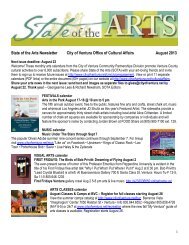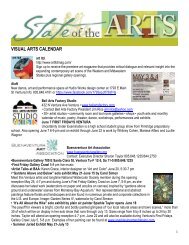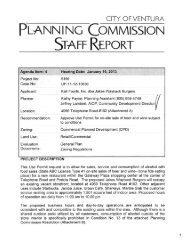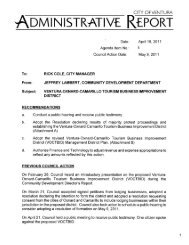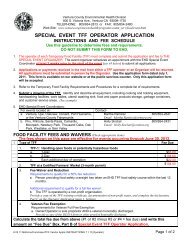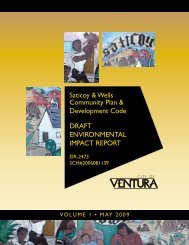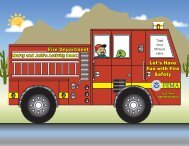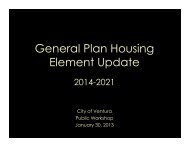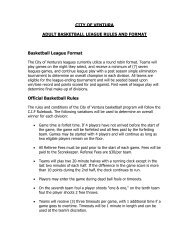2005 General Plan - City Of Ventura
2005 General Plan - City Of Ventura
2005 General Plan - City Of Ventura
Create successful ePaper yourself
Turn your PDF publications into a flip-book with our unique Google optimized e-Paper software.
O U R W E L L P L A N N E D A N D D E S I G N E D C O M M U N I T Y21 st Century Tool KitThe <strong>City</strong> has a wide array of tools at its disposalto achieve our “Infill First” strategy in ways thatrespect <strong>Ventura</strong>’s heritage and result in beautifulbuildings, blocks, streetscapes, and public placesthat enhance and enrich quality of life for theentire community. Shaping the <strong>City</strong>’s physicalform in the 21 st Century will be achieved mosteffectively and aesthetically by combining<strong>Plan</strong>ning Designations with a transect-basedapproach, and with a new form-basedDevelopment Code. Together these can stronglyinfluence the design and functioning of <strong>Ventura</strong>’sdistinct and unique neighborhoods, districts, andcorridors.The policies and actions in this chapter seek toenrich <strong>Ventura</strong>’s urban fabric through appropriatedesign that showcases the attractive features ofneighborhoods, districts, and corridors. Topromote high-quality infill, the policies and actionsencourage neighborhood centers, pedestrianaccess, established and desirable building types,and dynamic, neighborhood-serving nodes ofmixed-use development along primary streetsand corridors. This chapter specifically calls fordetailed attention to community design through aform-based approach.houses disconnected from surrounding places.Instead it is an identifiable area containing aneighborhood center with a pedestrian-friendlymix of uses and a palette of housing types forpeople in all stages of their lives. Neighborhoodsare often defined by a quarter-mile “pedestrianshed” (see Figure 3-2), in which most residents’daily needs can be met within a five-minute walk.The organic nature of neighborhoods and theirinterdependency is what makes them viable forgenerations. Neighborhoods are not staticplaces that resist change, but rather evolvenaturally through periods of transformation toaccommodate new residents’ needs and desires.“In a neighborhood, everything that is needed isthere and everything that is there is needed.”- AnonymousNeighborhoods: The Basic Building Blocks ofCommunityLike any great city, <strong>Ventura</strong> has grown around thebasic unit of the neighborhood. A trueneighborhood is not a subdivision of similar<strong>Ventura</strong> <strong>General</strong> <strong>Plan</strong>August 8, <strong>2005</strong> 3-7




